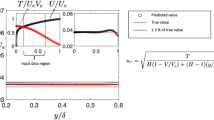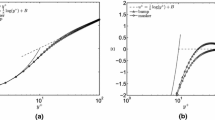Abstract
Boundary-layer experiments that use hotwire anemometry often perform least-squares fits of the boundary-layer velocity profile to estimate the position of the wall in the hotwire’s coordinate frame. This approach fails in the wake of roughness elements where the profile is nonlinear at the wall. A modified approach makes least-squares fits only at selected locations outside roughness wakes and estimates the wall location across entire lines using a function generated from these estimates. Comparing these two approaches shows that the first produces incorrect results just behind roughness elements but that the techniques produce identical results farther downstream.





Similar content being viewed by others
References
Gaster M, Grosch CE, Jackson TL (1994) The velocity field created by a shallow bump in a boundary layer. Phys Fluids 6:3079–3085
Joslin RD, Grosch CE (1995) Growth characteristics downstream of a shallow bump: computation and experiment. Phys Fluids 7:3042–3047
Kendall J (1981) Laminar boundary layer velocity distortion by surface roughness: effect upon stability. AIAA Paper 81-0195
Klebanoff PS, Cleveland WG, Tidstrom KD (1992) On the evolution of a turbulent boundary layer induced by a three-dimensional roughness element. J Fluid Mech 237:101–187
Reed HL, Saric WS (1989) Stability of three-dimensional boundary layers. Ann Rev Fluid Mech 21:235–284
Reshotko E (2001) Transient growth – a factor in bypass transition. Phys Fluids 13:1067–1075
Saric WS, Reed HL, Kerschen EJ (2002) Boundary-layer receptivity to freestream disturbances. Ann Rev Fluid Mech 34:291–319
Saric WS, Reed HL, White EB (2003) Stability and transition of three-dimensional boundary layers. Ann Rev Fluid Mech 35:413–440
Schmid PJ, Henningson DS (2001) Stability and transition in shear flows. Springer, Berlin Heidelberg New York
Schubauer GB, Skramstad HF (1947) Laminar boundary layer oscillations and stability of laminar flow. J Aero Sci 14:69–78
White EB (2002) Transient growth of stationary disturbances in a flat plate boundary layer. Phys Fluids 14:4429–4439
White EB, Ergin FG, Rice JM (2004) Receptivity of transient disturbances to surface roughness: amplitude effects. Phys Fluids (submitted)
Acknowledgements
The authors wish to thank the Air Force Office of Scientific Research for its support under grant F49620-02-1-0058. FGE thanks and acknowledges the Institute of International Education and the Case School of Engineering for supporting him with a Fulbright Fellowship and a Case Prime Fellowship, respectively.
Author information
Authors and Affiliations
Corresponding author
Rights and permissions
About this article
Cite this article
White, E.B., Ergin, F.G. Using laminar-flow velocity profiles to locate the wall behind roughness elements. Exp Fluids 36, 805–812 (2004). https://doi.org/10.1007/s00348-003-0766-y
Received:
Accepted:
Published:
Issue Date:
DOI: https://doi.org/10.1007/s00348-003-0766-y




